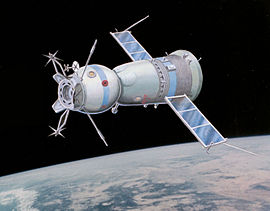
Back Sojoes-program Afrikaans Programa Soyuz AN برنامج سايوز Arabic Programa Soyuz AST Союз Bulgarian সয়ূজ কর্মসূচি Bengali/Bangla Programa Soiuz Catalan Soyuz Welsh Sojuz-programmet Danish Πρόγραμμα Σογιούζ Greek
| Союз Космическая Программа Soyuz Kosmicheskaya Programma | |
 Artist's impression of the Soyuz 19 spacecraft from the Apollo–Soyuz mission | |
| Program overview | |
|---|---|
| Country | Soviet Union Russia |
| Organization | Roscosmos (1991–present) |
| Status | Ongoing |
| Programme history | |
| First crewed flight | Soyuz 1 |
| Launch site(s) | Baikonur |
| Vehicle information | |
| Uncrewed vehicle(s) | Progress |
| Crewed vehicle(s) | Soyuz |
| Crew capacity | 1–3 |
| Launch vehicle(s) | |
| Part of a series of articles on the |
| Soviet space program |
|---|
The Soyuz programme (/ˈsɔɪjuːz/ SOY-yooz, /ˈsɔː-/ SAW-; Russian: Союз [sɐˈjus], meaning "Union") is a human spaceflight programme initiated by the Soviet Union in the early 1960s. The Soyuz spacecraft was originally part of a Moon landing project intended to put a Soviet cosmonaut on the Moon.[1] It was the third Soviet human spaceflight programme after the Vostok (1961–1963) and Voskhod (1964–1965) programmes.[2]
The programme consists of the Soyuz capsule and the Soyuz rocket and is now the responsibility of the Russian Roscosmos.[3][4] After the retirement of the Space Shuttle in 2011, Soyuz was the only way for humans to get to the International Space Station (ISS) until 30 May 2020, when Crew Dragon flew to the ISS for the first time with astronauts.[4][5]
- ^ Harland, David M. "Soyuz". Encyclopedia Britannica. Archived from the original on 27 February 2022. Retrieved 20 February 2022.
- ^ Hendrickx, Bart (2018). "Russian Life Support Systems: Vostok, Voskhod, and Soyuz". In Seedhouse, Erik; Shayler, David J. (eds.). Handbook of Life Support Systems for Spacecraft and Extraterrestrial Habitats. Springer International Publishing. pp. 1–15. doi:10.1007/978-3-319-09575-2_39-1. ISBN 978-3-319-09575-2. Archived from the original on 20 February 2022. Retrieved 20 February 2022.
- ^ Wild, Flint (27 June 2018). "What Is the Soyuz Spacecraft?". NASA. Archived from the original on 23 January 2022. Retrieved 20 February 2022.
- ^ a b O'Callaghan, Jonathan (9 April 2020). "The Last Soyuz - NASA Ends Reliance On Russia With Final Launch Before Crew Dragon". Forbes. Archived from the original on 20 February 2022. Retrieved 20 February 2022.
- ^ Luscombe, Richard; Sample, Ian (30 May 2020). "SpaceX successfully launches Nasa astronauts into orbit". The Guardian. Archived from the original on 31 May 2020. Retrieved 20 February 2022.